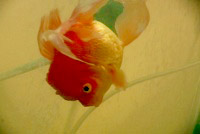Experiences with Dropsy in Goldfish
Dropsy is one of the worst diseases goldfish can come down with. It’s usually fatal. I hope this description of one goldfish that survived a bout of dropsy will help someone to save their fish.
Fish are said to have the disease “dropsy” when they swell up and their scales stand out all over like a pinecone. As JoAnn the Goldfish Guru says, “Dropsy is a SYMPTOM of other problem(s) with the fish. Dropsy can be due to problems with the environment (water quality, temperature shock, alkalinity), parasites, bacteria or virus.” Dropsy is apparently caused by bacterial infections and kidney failure.

Eggdrop in a happy moment. He has never been able to swim correctly, so he uses the bubblers to get around.
